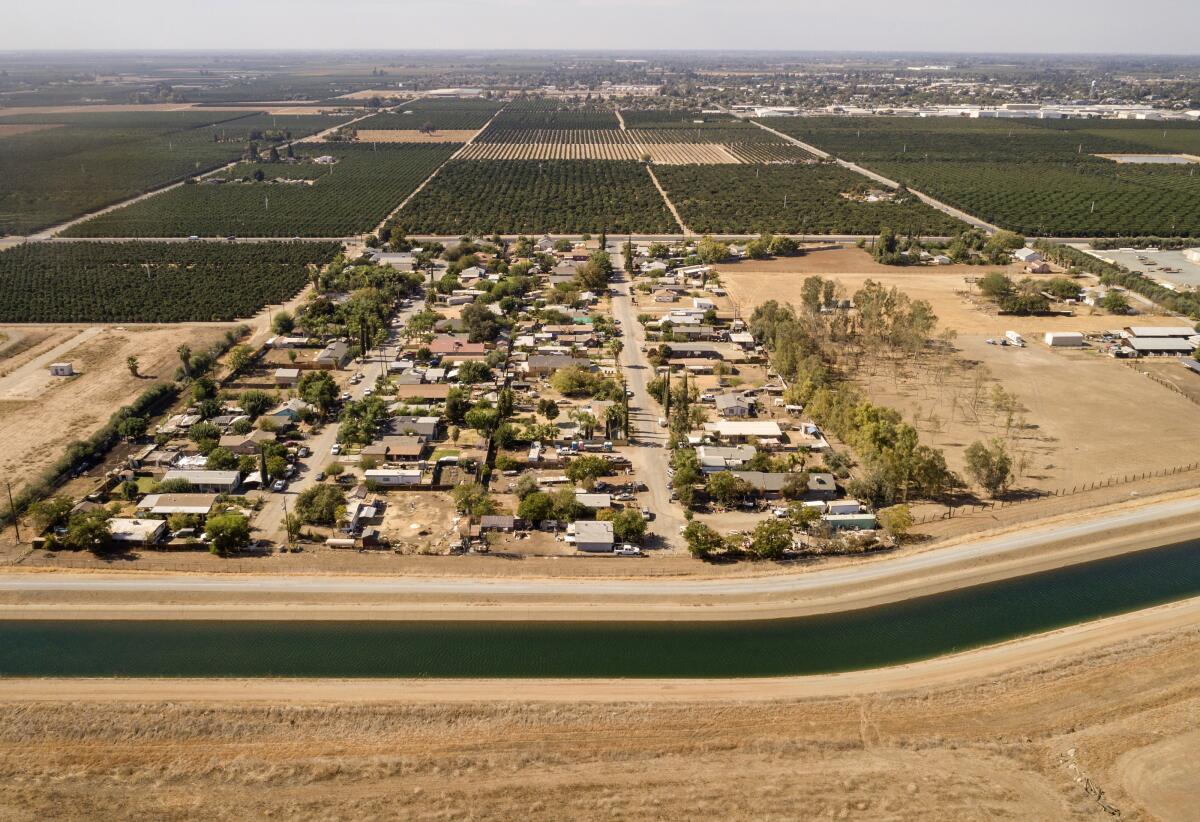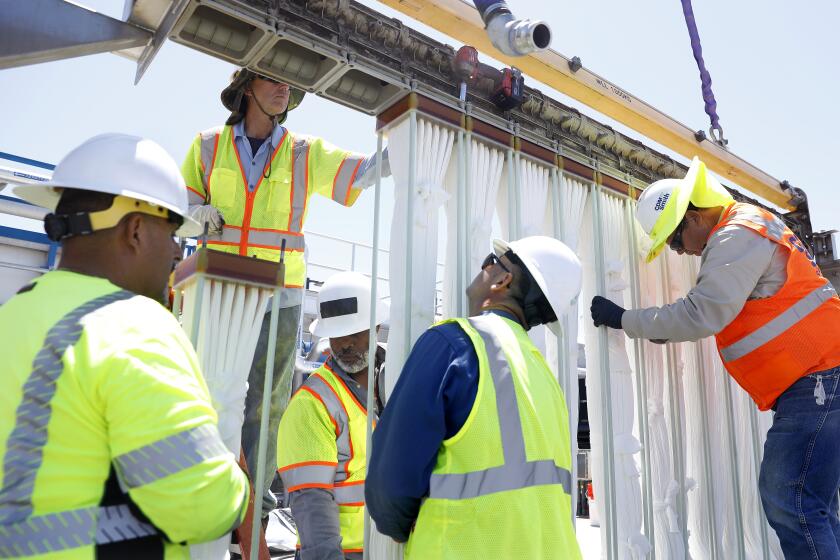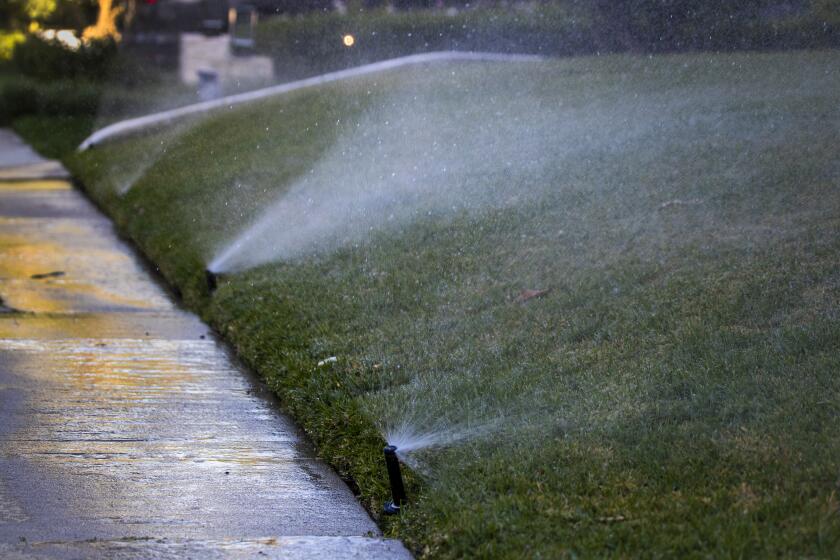Clean drinking water is a human right. Why are so many California communities without it?

- Share via
Barely a month after he took office in 2019, Gov. Gavin Newsom journeyed to a rural school in the Central Valley and stood by chance against a backdrop more prescient than he had planned: a classroom whiteboard that posed the “Essential Question — How do you respond to challenges?”
The governor had chosen Riverview Elementary School, in Parlier, to dramatize his first bill-signing, an interim fix to provide tens of millions of dollars to buy bottled water for communities with contaminated wells. “We can’t even provide basic drinking water to a million-plus Californians?” Newsom said, before posing for photo ops where drinking fountains had been sealed for more than a year. “Pathetic.”
He vowed to find money to finance permanent solutions to the problem, most prevalent in the Central Valley. “I don’t deserve to be your governor if I can’t figure out a way to get that done.”
More than a decade after California passed the Human Right to Water Act, about 1 million residents still lack access to clean, safe, affordable water.
A few months later, he and the Legislature did find funds: $1.3 billion over 10 years to help hundreds of small water districts that rely on groundwater from wells that have gone dry or become contaminated by agricultural and industrial waste.
Finding the money has turned out to be the easy part. Five years after the governor’s visit, students at Riverview still drink bottled water.
Faced with attitudes toward state government that range from distrust to low expectations, Sacramento officials have struggled to forge partnerships in communities divided by class and race. For once, the state has money, along with increased authority to force changes. What’s missing is leadership to disrupt a process where intolerable delays are accepted as inevitable.
The plight of Tooleville, with wells running dry, inspired a new law that gives the state power to mandate water consolidation with a neighboring town.
The State Water Resources Control Board, which administers the $1.3-billion drinking water program, has awarded hundreds of millions of dollars in planning, technical assistance and construction grants, and some progress has been made. But water districts are joining the failing list as fast as they are moving off it. Of California’s 3,000-plus water districts, the most recent data show 386 systems failing, 507 at risk and 403 more potentially at risk.
The state’s inability to get ahead of the crisis is due in part to complications made worse by intransigence, in part to better data and stricter safety standards that implicate more systems, and in part to drought and climate change. But it’s also due to reliance on a state agency built for regulatory functions, now called on to collaborate with struggling and polarized communities and ensure pipelines get built. The water board took particular umbrage at the title of a recent state audit that criticized its lack of urgency; it is hard to see how any other word could be appropriate.
The red dots on the water board’s map that tracks water systems dependent on unsafe or dry wells are clustered in unincorporated areas, overwhelmingly lower income, home to people of color, historically shut out of cities by racial covenants and redlining. Forced to live in places without public services, they dug wells, and when the wells ran dry, they dug deeper. The most realistic solution for many of these communities is to consolidate — with the local governments that historically shut them out.
Sewage will be extensively treated, transformed into pure drinking water and delivered directly to people’s taps.
In Tulare County, the hostility now is more veiled than in the 1970s, when the General Plan deemed 15 communities nonviable and recommended withholding public services, including water, so they would “enter a process of long term, natural decline” and fade away. Thirteen are still around. One of them is Tooleville, 77 homes separated from the Sierra Nevada foothills by the Friant-Kern Canal, full of water the residents cannot touch. The state pays for each home to receive six five-gallon jugs every two weeks.
For decades, the solution has been clear: Connect Tooleville with the city of Exeter’s water supply — less than one mile away. Exeter refused, repeatedly. After state money became available to cover the added costs, and it seemed the city had run out of excuses, the council voted unanimously to discontinue talks. “We have our own issues,” Exeter Mayor Mary Waterman-Philpot told a roomful of Tooleville residents, snorting at the idea the state would pay for the one-mile extension. “I’d like Santa Claus to come do things, too.”
The L.A. County Board of Supervisors has adopted the county’s first water plan, which outlines how the region must stop importing 60% of its water by 2045.
Eventually, the state ordered them to consolidate; an agreement was finalized last year. A short-term fix to connect Tooleville homes to Exeter’s water is supposed to be in place by September, but the full project is estimated to take eight years.
In the nearby hamlet of Tombstone, a $3-million project that was supposed to be finished in 2022 is now a $6-million project with an estimated completion at the end of 2026, delayed by difficulties negotiating with owners of land needed to run one mile of pipe to connect to a nearby system.
Such facts, as Newsom has said about the overall water crisis, would not be tolerated in Beverly Hills. Of the many entrenched inequalities plaguing California, the uncontroversial goal of clean drinking water should be relatively attainable.
The Essential Question on the white board in the Parlier school remains as unresolved as the solution to the school’s water supply: how to meet the challenges.
California water regulators proposed conservation rules for cities. A legislative review found the rules, as written, would be costly and complex to implement.
Newsom is on the record: “That we’re living in a state with a million people that don’t have access to clean, safe, affordable drinking water is a disgrace.” In 2019, he took his Cabinet to the Central Valley to impress upon top aides the import of the drinking water issue. In his first State of the State, the governor stressed that correcting the crisis would “demand political will from each and every one of us.”
Newsom needs to renew and revisit that commitment, and use both his power and his bully pulpit to analyze delays and impose urgency, so that actions live up to rhetoric.
Miriam Pawel is the author of, among other books, “The Crusades of Cesar Chavez: A Biography.” She is at work on a history of the University of California.
More to Read
A cure for the common opinion
Get thought-provoking perspectives with our weekly newsletter.
You may occasionally receive promotional content from the Los Angeles Times.














